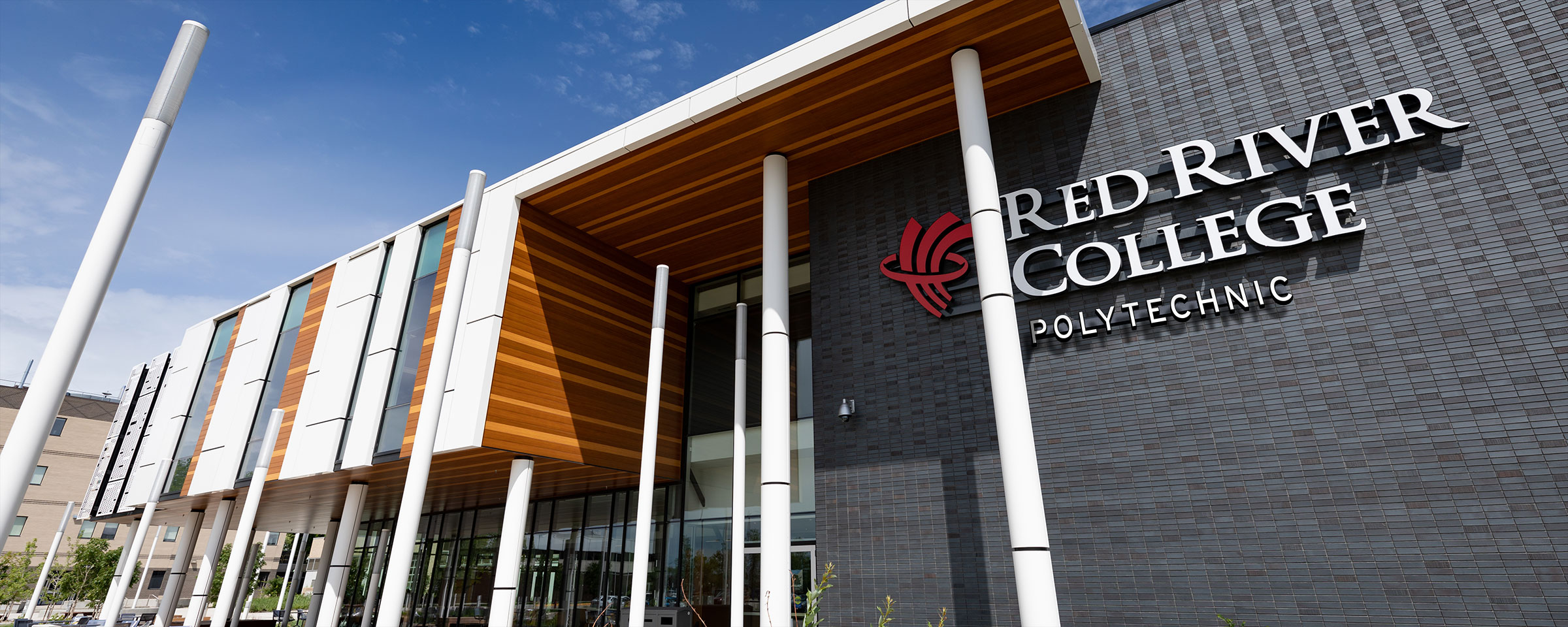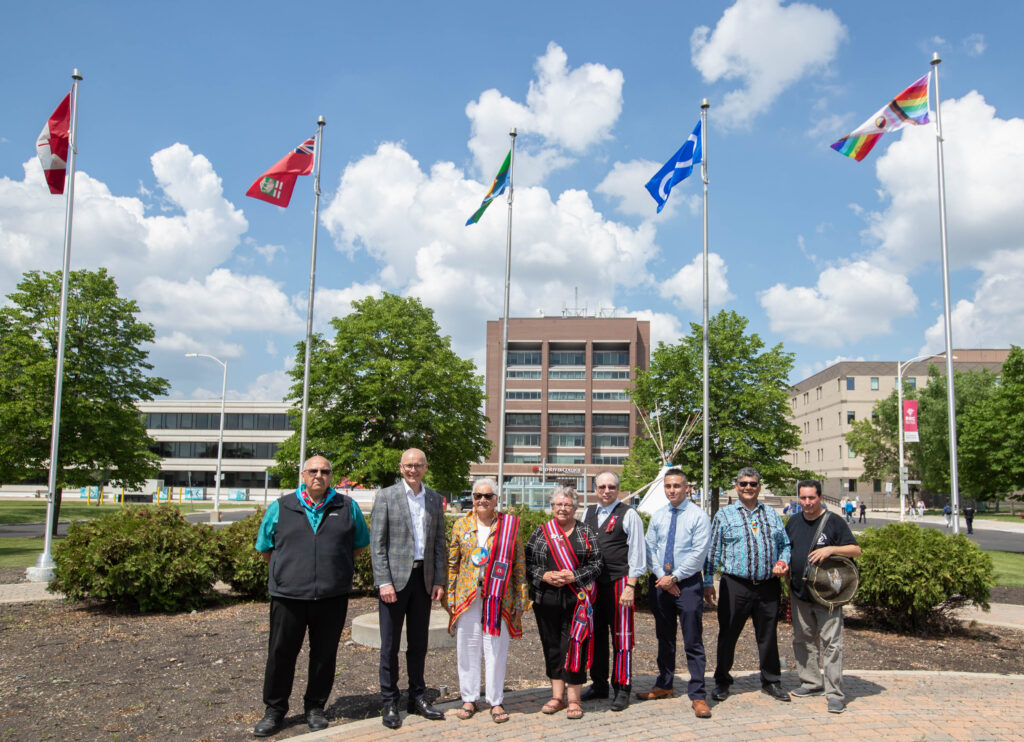Treaty One Nation, Red River Métis and Pride flags raised at RRC Polytech
This week, RRC Polytech raised three flags in an act of unity, pride and inclusivity to mark the beginning of National Indigenous History Month and Pride Month.
The Treaty One flag, Red River Métis flag and RRC Polytech’s new inclusive Pride flag will now fly year-round at the Notre Dame Campus in Winnipeg to acknowledge the history of the land, respect for the treaties made on the land, and representation of the people who live here.
“RRC Polytech is committed to enacting Truth and Reconciliation and equity, diversity and inclusion in everything we do. A big part of that is creating representative and inclusive spaces on our campuses,” says Fred Meier, President and CEO of RRC Polytech.
“By raising these three flags, we are demonstrating to staff, students and community members that this is a place where you belong. We know that there are still institutions and situations where 2SLGBTQIA+, Indigenous and Métis people don’t feel welcome or recognized, but at RRC Polytech we are sending a firm message that everybody belongs and is welcome here.”
The flag-raising was attended by representatives from the Manitoba Métis Federation (MMF), Peguis First Nation, Sandy Bay Ojibway First Nation and RRC Polytech’s Knowledge Keepers Council, along with Elders and Knowledge Keepers from Treaty One Territory. Ray “Coco” Stevenson provided a hand-drum flag song for the ceremony.
Treaty One Flag
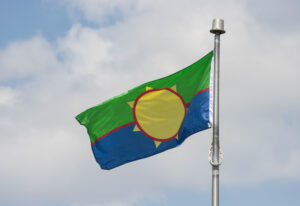 Treaty One represents Anishinaabe (Ojibwe) and Nehiyaw (Cree), original peoples of the territory of present-day southern Manitoba, including the forks of the Assiniboine and Red rivers, a vital trade and gathering site. Treaty One Nation comprises the seven First Nations that were signatories to the first of the numbered treaties, originally signed in 1871 at Lower Fort Garry.
Treaty One represents Anishinaabe (Ojibwe) and Nehiyaw (Cree), original peoples of the territory of present-day southern Manitoba, including the forks of the Assiniboine and Red rivers, a vital trade and gathering site. Treaty One Nation comprises the seven First Nations that were signatories to the first of the numbered treaties, originally signed in 1871 at Lower Fort Garry.
“I am extremely proud to see RRC Polytech raise our Treaty One flag on their campus today. Despite the spirit and intent of the treaty, which has benefitted the people of Manitoba for over 150 years, we were continuously denied our rights, our titles, our jurisdictions, our culture, our language and our children,” says Treaty One chairperson Chief Gordon Bluesky, of Brokenhead Ojibway First Nation.
“Despite our darker periods of history, we are still standing strong, and each one of these flag-raising ceremonies is a concrete, tangible expression to our Treaty Partners that we are still here. Today, we can all look forward to a brighter future for the next generations and feel the pride in sharing the history of Indigenous peoples on this land. Through these actions of reconciliation, our young Indigenous learners have a very bright future ahead.”
Elements of the Treaty One flag symbolize the original spirit and intent of the treaties: green to represent the grass, blue to represent the waters, and yellow to represent the sun. The red represents the circle of life and the Indigenous people who inhabit this land. The seven points around the sun represent the seven signatory First Nations.
Red River Métis Flag
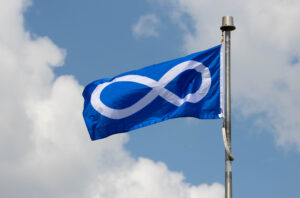 The Red River Métis have a rich and important history, language and culture. The Red River Settlement — now Winnipeg — is the heart of the Red River Métis Homeland and the birthplace of the nation.
The Red River Métis have a rich and important history, language and culture. The Red River Settlement — now Winnipeg — is the heart of the Red River Métis Homeland and the birthplace of the nation.
“The Red River Métis have been fighting to have our rich culture, heritage and history recognized and respected for over 200 years,” says Joan Ledoux, the MMF’s Minister of Provincial Education and Associate Minister of Métis Employment.
“Manitoba is the only province in Canada to have been brought into confederation by an Indigenous nation with the signing of the Manitoba Act in 1870, intertwining the history of the Red River Métis with the history of Manitoba. Today, the MMF, the National Government of the Red River Métis, has made great strides in advancing our Nation and regaining our rightful place in Canada’s confederation. This flag-raising today is one small step toward a brighter future for our Red River Métis youth, ensuring that they know their identity is recognized and celebrated as they achieve their educational goals.”
RRC Polytech recognizes the impact the Red River Métis had in the formation of this city, province and country. The Red River Métis were instrumental in confederation and fought battles to retain their rights throughout history — in the courtroom, in houses of government and on the battlefield.
RRC Polytech Pride Flag
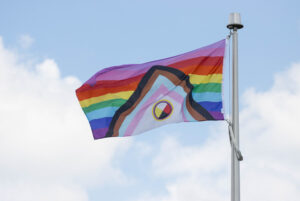 Last year, RRC Polytech unveiled its new Pride Flag, which was painted on pedestrian walkways at the Notre Dame, Exchange District and Portage Campuses. The flag will also be flown at the Paterson GlobalFoods Institute throughout the month of June.
Last year, RRC Polytech unveiled its new Pride Flag, which was painted on pedestrian walkways at the Notre Dame, Exchange District and Portage Campuses. The flag will also be flown at the Paterson GlobalFoods Institute throughout the month of June.
The new Pride design is an evolution of the Progress Pride flag that includes representation for all 2SLGBTQIA+ (Two-Spirit, Lesbian, Gay, Bisexual, Transgender, Queer and/or Questioning, Intersex and Asexual) community members, and includes specific Indigenous elements. It was designed in consultation with the College’s Knowledge Keepers’ Council, Students’ Association, and Gender and Sexual Identities working group, and with representatives from the Rainbow Resource Centre.
The flag’s triangle represents the inverted pink triangles LGBT prisoners were forced to wear in Nazi concentration camps. It’s location at the bottom of the flag also forms a tepee shape, representing shelters used throughout history by many First Nations people in Manitoba. The Medicine Wheel incorporates traditional Indigenous knowledge and teachings, while the purple and yellow circles around the Medicine Wheel recognize intersex folx.
“At RRC Polytech we are committed to our reconciliation journey as we walk the path of understanding, respect and advocacy with the 2SLGBTQIA+ community,” says Vera Godavari, Equity, Diversity and Inclusion Specialist. “As a learning organization, we celebrate our progress and continue our dedication to this important work through these ongoing initiatives.”
